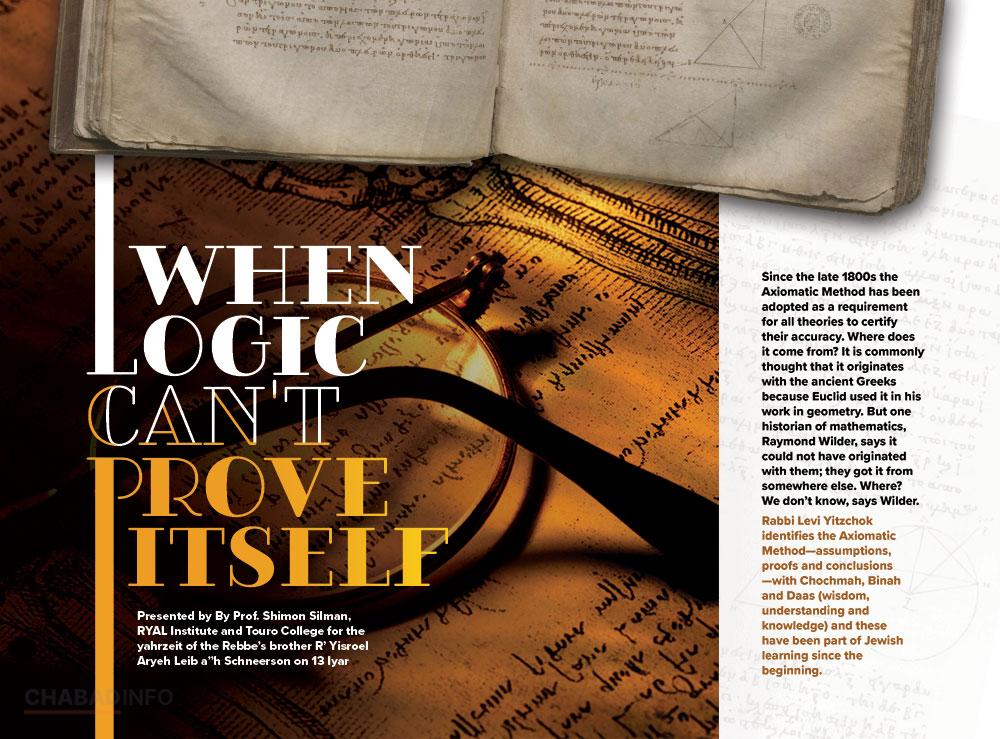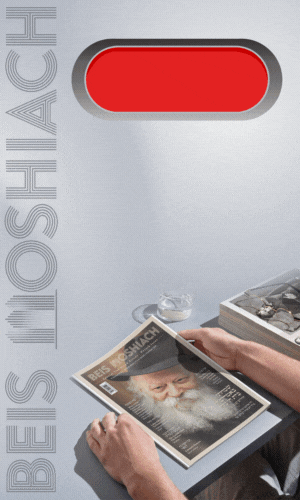When Logic Can’t Prove Itself
Since the late 1800s the Axiomatic Method has been adopted as a requirement for all theories to certify their accuracy. Where does it come from? It is commonly thought that it originates with the ancient Greeks because Euclid used it in his work in geometry. But one historian of mathematics, Raymond Wilder, says it could not have originated with them; they got it from somewhere else. Where? We don’t know, says Wilder • By Prof. Shimon Silman, Beis Moshaich magazine • Full story
Prof. Shimon Silman, Beis Moshiach
This article is being presented in memory of R’ Yisroel Aryeh Leib Schneerson on the occasion of his 70th yahrtzeit, 13 Iyar, 5782, and in honor of the 30th anniversary of the institute established in his memory, the RYAL Institute for Moshiach and Science Research.
Reb Yisroel Ayeh Leib was known for his expertise in Chassidus, mastering the difficult Maamorim of 5666 (“baki in gantz samech-vav”). He was a man of great intellect. His trademark was explaining the abstract concepts of Chassidus in simple language. If he could not explain something from Chassidus in everyday language, he would say that he does not yet understand it completely.
He held a position in the Department of Mathematics at the University of Liverpool. His well-known mathematical paper, “The Location of Eigenvalues and Eigenvectors of Complex Matrices,” is published in the Journal of Approximation Theory.
The Birth of Man—and the Animal
A child and an animal are born. The animal learns to find food so that it can live—so that its physical needs are taken care of; the child learns the same thing—to find food, to be held…As far as higher concepts are concerned, they both start from nothing.
But the child has a different brain (and a soul) so it’s constantly looking around and picking up things, while the animal just looks for more food.
Later as they get closer to their adult years, we see a big difference: the animal is still looking for food, maybe learning to kill other animals for food, but that’s all. While the child, now a teenager who has been looking around and picking up things, starts to think—yes, think: “Who am I, what am I, how did I get here, what am I here for? Is there, perhaps, a purpose?”
He meets a Lubavitcher who tells him, “Listen, there are very deep issues…throughout your life you will learn and hopefully find some answers. Right now, you have to follow the path of Torah and Mitzvos.” He meets an intellectual who tells him, “No. You have to follow your intellect and make your own decisions. You will decide what to do, and do what you feel is correct.” He meets a carefree teenager who says to him, “What do you need all this for? Here, take some of these drugs and all your questions will be answered.” As King Solomon put it in Koheles, “Rejoice, young man, in your youth.”
Meanwhile, the animal goes on eating. He finds food, eats it and continues to live.
What is the teenager to do? Well, he takes the easy way out and tries the drugs. Lo and behold! His questions go away! But after he comes down from his high, all his questions come back—even stronger. So, he thinks, one of the other two guys must be right. He is attracted to the intellectual because he’ll think on his own, make his own decisions and acts accordingly—on his own. No one is going to tell him what to do, or even what to think.
At this point we have to ask, “How far is this going to get him? Will his own intellect come up with answers to the questions that scholars have been struggling with for millennia?
So, what is intellect and how far can it go?
The Roots of The Axiomatic Method
Rabbi Levi Yitzchok writes in one of his letters to the Rebbe MH’M (24 Teves, 1932), that all intellect is based on assumptions (axioms), followed by methods of proof from the axioms, finally reaching a conclusion. This is known in modern thought—especially modern mathematics—as the Axiomatic Method.
But where does the Axiomatic Method come from? It is commonly thought that it originates with the ancient Greeks because Euclid used it in his work in geometry. But one historian of mathematics, Raymond Wilder, points out that it could not possibly have originated with the Greeks because it is very sophisticated and such a system usually develops over time. You see the beginning of it in one generation, a further development of it in the next generation, and so on. But what we find is that all of a sudden, the Greeks are using the complete system. So, Wilder says, it could not have originated with them; they got it from somewhere else. Where? We don’t know, says Wilder.
But Rabbi Levi Yitzchok identifies the Axiomatic Method—assumptions, proofs and conclusions—with Chochmah, Binah and Daas (wisdom, understanding and knowledge) and these have been part of Jewish learning since the beginning. The Torah speaks of them. So I am certain that the Greeks got the Axiomatic Method from the Jews. This is not at all surprising because we find this in other sciences. Rambam writes that he used the proofs of the Greek astronomers for his Hilchos Kiddush HaChodesh, but points out that back in the time of the Beis HaMikdash, when the Sanhedrin did the calculations and declared the beginnings of the Jewish months, we had this knowledge. The tribe of Yissachar specialized in this and wrote books on it. The Kuzari says explicitly that the Greeks got this science from us.
In the late 1800s the Axiomatic Method was adopted as a requirement for all theories to certify their accuracy…
So now our friend is back to the 3rd guy he met when he was a teenager—The Lubavitcher who told him to follow the Torah, or as King Solomon says at the end of Koheles, “In conclusion, all arguments having been heard, fear G-d and keep His commandments, for that is the entirety of man.”
Limitations of the Intellect
So, all logic and intellect are limited and can only get us so far. We will consider two examples of logical proof, first something clear, simple and actually visual; then something impossible.
Consider first the famous theorem (mathematical fact) that a² + b² = c², where a and b are the legs of a right triangle, and c is the hypotenuse.
[Rather than present the proof here, we refer the reader to two YouTube videos.
For a clear, visual proof, see https://www.youtube.com/watch?v=wnl0O_xkgzs&t=8s. For an even more visual, physical example of this, see https://www.youtube.com/watch?v=-iHz3mq8kM4.]
This proof has all the advantages: It’s completely logical, simple, visual—and true! This mathematical fact has even become part of Torah. It is used by the Tosafos Yom Tov on the Mishneh in Kilayim.
This theorem is an example of 2VL, where there are only 2 values—True and False. Every statement is either true or false. (Quantum mechanics uses 3VL—a three-valued logic, where contradiction is also a possibility. But this is a subject for another paper.)
Now let’s take a logical problem—a question in logic itself—known as the Barber Paradox:
You come to a town and you want to get a haircut. They tell you that there is a certain barber there who cuts the hair of all the people who do not cut their own hair—and only those people. So, you go to that barber and ask him for a haircut. As he’s cutting your hair, you start thinking about the barber and you ask him, “Tell me, sir, do you cut your own hair?” He thinks for a moment and then goes crazy. You asked him a question that cannot be answered. For, if he does not cut his hair, then since he’s one of the people who do not cut their own hair, well, those are exactly the people whose hair he does cut. And if he does cut his own hair, then he is not one of the people who do not cut their own hair, and those are the people whose hair he does not cut. If he does not then he does, and if he does then he does not. It’s a paradox.
Logic itself has no answer to this. This paradox has many forms in logic and set theory. The way out of this is to say that we reject self-referral, entities that refer to their own selves; we limit our theories to discuss only issues that do not refer to themselves; a theory cannot talk about itself. This is the situation in the Two-Valued Logic that we use every day.
A similar situation occurs within logic itself. The famous logician Kurt Godel has shown that there are statements that cannot be shown to be either true or false.
So, we have placed a limit on human intellect; we have shown that intellect itself is limited.
In truth, logic itself is a creation—just like all human intellect—and all of creation is limited. And, like all creation, logic was created using the Torah. As the Zohar says: “G-d looked into the Torah to create the world.” What exactly does this mean in the case of logic?
The Rebbe MHM explains that the Torah has commandments but there are different kinds of commandments, some are “rational” (mishpatim)—like “don’t commit murder,” and some are “irrational” (chukim)—like “don’t eat pig.” G-d then created the human being with such a brain and such logic in the brain that the mishpatim make sense to us and the chukim are just decrees that we have to follow. We could just as easily have been created in such a way that “don’t eat pigs” makes sense to us, and “don’t kill” makes no sense.
Back to Our Friend…
Now let’s go back to our friend who has decided to follow the path of Torah. He is now learning in a Lubavitch yeshiva at the suggestion of his Lubavitcher friend.
He’s learning Gemara, Halacha and Tanya, of course, but as he advances somewhat, he also starts learning the Maamarim of Chassidus which talk about the deeper levels of reality—including an analysis of intellect itself!
One day, he comes upon a fascinating maamar called Kuntres 18 Nissan, 5751. It’s about birds! Well, more than just birds. It starts with a discussion of houses and yards. Houses are for people to live in and yards are for keeping their animals. But there are two kinds of yards—one with a fence and a roof and one without a roof, just a fence. The first is good for keeping birds and the second is good for cows, sheep and other land animals. After all, birds can fly so just a fence won’t keep them there—they’ll fly away. So, they need a roof to keep them there.
On a deeper level, the maamar continues, the animal represents the animal soul (Nefesh HaBahamis) of a person, and the bird represents the intellectual soul (Nefesh HaSichlis). Technically, the intellectual soul is part of the animal soul because while it thinks, it thinks in physical terms. But there is also a G-dly soul in the person (Nefesh HaElokis) which is a “part” of G-d, so to speak. It is all about Torah, mitzvos and G-d Himself. Of course, all of its thinking is in spiritual terms. But both of these souls are inside the person so they have to communicate. Now, the animal soul is finite while the G-dly soul is infinite so how do they communicate?
That’s where the Intellectual Soul comes in. It serves as sort of an intermediary. For example, the G-dly soul wants the physical person to keep mitzvos and learn Torah. So, it communicates this message to the intellectual soul which then turns around and says to the animal soul something like, “Look, you want a good physical life, right. Following Torah and mitzvos is the only way to have a good physical life. Trust me.”
Here’s where the yards come in. The animal soul, at its lowest level, is purely physical. This is represented by land animals—sheep, goats, cows. They know that they don’t understand anything about spirituality and are just interested in their physical needs and pleasures. It doesn’t take much to keep them in line—just a fence will do. But the intellectual soul (the higher part of the animal soul) is always looking up—it’s always looking for something higher. That’s the nature of intellect. Looking for new ideas, it may go off on a tangent. It can go wild. So, it needs an extra guard—it needs a roof to keep it in line. The roof tells it, “You don’t know everything; you can’t know everything. Stay in line.”
Even when the intellectual soul is acting as an intermediary between the animal soul and the G-dly soul, it may think that it fully understands the spirituality that it is being told and will communicate it accordingly. But the roof comes along and tells it, “Look, you are finite and the spiritual realm is infinite. You don’t know everything. You can’t possible fully comprehend the spirituality that you are being told.” The roof keeps it in line and reminds it that it is only finite and therefore its understanding is finite.
Our friend in yeshiva learns all this and proceeds with caution. Then he finds a letter from the Rebbe to a young man that explains it in a different way. In the letter (Igros Kodesh, no. 5,486) the Rebbe MH’M writes:
What is the wonder that man doesn’t understand what G-d understands (so to speak). On the contrary, the wonder is the opposite—that there are things from the wisdom and will of G-d, the Torah, that the man—who is finite—is able to understand in his finite intellect.”
So, the Tzemach Tzedek, explaining the correct path to follow, writes (Derech Mitzvosecha, Haamonas HaElokus) that we are supposed to have faith (Emuna) in the infinite wisdom of the Creator. To the best of our finite ability, we must try to understand the things that we believe. When we do reach an understanding, we go on to a higher aspect of faith that we have not yet been exposed to. This is an ongoing spiral that reaches higher and higher. (Eating matza on Pesach helps us accomplish this. Matza is called the “Food of Faith” (michla d’mehemnusa) in the Zohar. It represents faith; eating it brings this faith into our finite, physical being.)
We can only go higher and higher but we can never fully understand our Creator. This was expressed by one of the early scholars in the famous statement: The ultimate knowledge is that we cannot know You (G-d).
Our friend in yeshiva now has peace of mind. He knows what to do. And what man cannot do. This answers the questions he had as a teenager.
To See the Infinite in the Finite
Finally, we must point out that the finite and the infinite are not so separate. There are ways that we can “see” the infinite together with the finite—before our eyes. In the Era of Moshiach G-d essence (Atzmus) will be revealed. This is a level which is infinitely higher than both the finite and the infinite and will combine them both into one world order—the natural and the miraculous functioning together in a single world order.
By way of introduction, let’s talk for a moment about what we now call irrational numbers. These are numbers that may have an infinite decimal expansion, but with no repetition. For example, .33333 with the 3’s going on forever is NOT an irrational number even though the decimals go on forever because it has a pattern of repeated 3’s. It is a rational number (rational from the word ratio) because of the repeated pattern and can be converted into a ratio: 1/3, a fraction. But numbers such as the square root of 2, let’s write it as sqrt(2), are irrational because the decimal expansion 1.41459… goes on forever with NO repeated pattern. So, there is an aspect of infinity here—we can never know the full decimal expansion and it cannot be converted to a fraction. (This can be easily proved—but not now.)
So the Tzemach Tzedek, in a maamar titled “To Understand the Wonders of the Creator” (L’Havin Niflaos HaBoreh) points out that according to what we know about triangles (the formula a² + b² = c² mentioned above) if we have a right triangle, with a horizontal side of 1 and a vertical side of 1, the hypotenuse (diagonal side) will have the value of sqrt(2) which is irrational (as discussed above) and thus has an infinite, nonrepeating decimal expansion—infinity right before our eyes! We see 2 sides that have a definite finite length, and the 3rd side which has infinity embedded in it—because its length is irrational, its decimals go on forever and we cannot say how long it is.
As we are already in the Era of Moshiach, we look forward to Moshiach revealing that level where the finite natural order is blended with the infinite miraculous order to initiate one world order where The Atzmus of Hashem will be revealed. And we will see it, as the prophet says, “And the glory of G-d will be revealed, and all flesh shall see it…” (Isaiah 40:5)
“…On that day Hashem will be one, and His name will be One.” (Zecharia 14:9)
*
The magazine can be obtained in stores around Crown Heights. To purchase a subscription, please go to: bmoshiach.org
129
Join ChabadInfo's News Roundup and alerts for the HOTTEST Chabad news and updates!










































